No need for a degree to have common sense, just try calling ten different local retailers in your immediate area. See how many have a Li battery in stock for your application. Get in a brief conversation at several local battery replacement stores and ask installer his opinion on proper charging rates, or what voltages which battery should be at for what stage. You will most likely get a blank stare and not much of a response, you are correct though, you will get the most current and correct data in existence from MS, but he is one in a million, not quite what you'll find at the local autozone or walmart....
Batteries - What The Future Holds.......
- Thread starter Maine Sail
- Start date
Not a new idea. https://www.google.ca/search?site=&...true...0...1.1.60.hp..1.22.1978.0.6cYQUg8e5UkNot sure if this is true, but then again.... why not? A guy told me Milwaukee developed a heating sweatshirt that would use the batteries from it's tools. Hhmmm...
Have not done an update in a while... I built this 400Ah pack in 2012 and have since run over 775 cycles most to 80% DOD. It is still testing at beyond 400Ah.
For this test I chose to use an intervalometer (see video below) to actually make a movie of the discharge. The first frame is the charge end point of 13.8V and 7.5A flowing into the bank. The charger then turns off and the constant load discharge tester turns on. The bank was discharged at 30A and I have been using this tester for its repeatability. At a .5C or 1C load the Ah capacity would be slightly less but with the low Peukert of LFP not by a huge margin.
A guy in the off-grid LiFePO4 community (Terry) suggested that LFP banks can develop a situation where you may not see all the true capacity after repeated light discharges. I had also noted this in an over-discharged Mastervolt marine battery where I was able to see continual capacity increase in each cell as a kept cycling them to 2.7V then back to 100%. I decided to test this theory on this bank by conducting multiple 100% discharges followed by 100% recharges.
This test was conducted at cycle # 772 and done at a .075C discharge rate. This rate is limited by my constant load dischargers ability.
Here's the video: (if you click for full screen you can more clearly see the capacity testers screen.)
Before you get too excited, these cells have:
--Never been floated, they get charged, then discharged
--Only absorbed to a net 8A - 10A at 13.8V -14.0V
--Not charged above 14.0V unless for testing purposes (I now have a few other banks for that)
--Max charge rate at approx .3C
--Stored at 50% SOC when not being used or cycled
--Stored in 45-60F temps when not being used or cycled
--Only very rarely exceeded 80F
--Highest voltage they have ever seen was 3.8VPC while top balancing initially.
On these last few capacity tests I ran a total of seven 100% DOD tests back to back and noted that I gained nearly 15.3 Ah's of capacity from test #1 to test #7. I meant to do five tests but the video quality messed with me a few times and I am still not entirely happy with it. This resulted in two extra tests. There seems to be some truth to what Terry had been suggesting about light loads diminishing/masking some of the real true capacity.
My last published capacity test was at cycle #550 (I generally conduct them every 50 cycles) and it delivered 419.2Ah. Most tests since I began using the constant load tester have been within a few Ah's of this 419.2Ah cycle 550 mark. These however have been just 1 capacity test and to a lower cut off voltage of 2.8 volts per cell. I now use 2.9 volts per cell because I noted very little capacity below 2.9V and voltage starts to drop off rapidly below this (lower knee).
I suspect I did not see as much gain with the back to back 100% DOD cycles as Terry had because I am normally discharging this bank to 80% DOD & then recharging at .23 - .3C.
With a total of seven back to back Ah capacity tests at a .075C discharge rate I did see an increase of about 15.3 Ah before the Ah capacity stabilized and stopped increasing. What does this mean? I don't know, but I did see an increase of 15.3 Ah by cycling this bank from 100% to 0% seven times back to back.
This LFP bank is an n=1.... In science an n=1 is not sufficient data. Cells vary and every boater will treat them differently. I have customers with over 12 years on GEL batteries (one at 16 years) and others who murder them in 2 years. I know of a number of owners who've murdered LiFePO4 banks. I have a dead $10,000.00 factory made "Marine LiFePO4 battery" in my shop as evidence of that.
I am treating this LFP bank how I suspect & have surmised they do well with, in a PSOC environment, and it seems to be working, but an n=1 really tells us little in the whole scheme.
The frustrating part is that very few of us in the LFP community are actually capacity testing, with repeatable equipment, to know what is actually happening with our LFP banks. Until more fractional C data in a PSOC use situation comes out, it's learn it as we go.
For this test I chose to use an intervalometer (see video below) to actually make a movie of the discharge. The first frame is the charge end point of 13.8V and 7.5A flowing into the bank. The charger then turns off and the constant load discharge tester turns on. The bank was discharged at 30A and I have been using this tester for its repeatability. At a .5C or 1C load the Ah capacity would be slightly less but with the low Peukert of LFP not by a huge margin.
A guy in the off-grid LiFePO4 community (Terry) suggested that LFP banks can develop a situation where you may not see all the true capacity after repeated light discharges. I had also noted this in an over-discharged Mastervolt marine battery where I was able to see continual capacity increase in each cell as a kept cycling them to 2.7V then back to 100%. I decided to test this theory on this bank by conducting multiple 100% discharges followed by 100% recharges.
This test was conducted at cycle # 772 and done at a .075C discharge rate. This rate is limited by my constant load dischargers ability.
Here's the video: (if you click for full screen you can more clearly see the capacity testers screen.)
Before you get too excited, these cells have:
--Never been floated, they get charged, then discharged
--Only absorbed to a net 8A - 10A at 13.8V -14.0V
--Not charged above 14.0V unless for testing purposes (I now have a few other banks for that)
--Max charge rate at approx .3C
--Stored at 50% SOC when not being used or cycled
--Stored in 45-60F temps when not being used or cycled
--Only very rarely exceeded 80F
--Highest voltage they have ever seen was 3.8VPC while top balancing initially.
On these last few capacity tests I ran a total of seven 100% DOD tests back to back and noted that I gained nearly 15.3 Ah's of capacity from test #1 to test #7. I meant to do five tests but the video quality messed with me a few times and I am still not entirely happy with it. This resulted in two extra tests. There seems to be some truth to what Terry had been suggesting about light loads diminishing/masking some of the real true capacity.
My last published capacity test was at cycle #550 (I generally conduct them every 50 cycles) and it delivered 419.2Ah. Most tests since I began using the constant load tester have been within a few Ah's of this 419.2Ah cycle 550 mark. These however have been just 1 capacity test and to a lower cut off voltage of 2.8 volts per cell. I now use 2.9 volts per cell because I noted very little capacity below 2.9V and voltage starts to drop off rapidly below this (lower knee).
I suspect I did not see as much gain with the back to back 100% DOD cycles as Terry had because I am normally discharging this bank to 80% DOD & then recharging at .23 - .3C.
With a total of seven back to back Ah capacity tests at a .075C discharge rate I did see an increase of about 15.3 Ah before the Ah capacity stabilized and stopped increasing. What does this mean? I don't know, but I did see an increase of 15.3 Ah by cycling this bank from 100% to 0% seven times back to back.
This LFP bank is an n=1.... In science an n=1 is not sufficient data. Cells vary and every boater will treat them differently. I have customers with over 12 years on GEL batteries (one at 16 years) and others who murder them in 2 years. I know of a number of owners who've murdered LiFePO4 banks. I have a dead $10,000.00 factory made "Marine LiFePO4 battery" in my shop as evidence of that.
I am treating this LFP bank how I suspect & have surmised they do well with, in a PSOC environment, and it seems to be working, but an n=1 really tells us little in the whole scheme.
The frustrating part is that very few of us in the LFP community are actually capacity testing, with repeatable equipment, to know what is actually happening with our LFP banks. Until more fractional C data in a PSOC use situation comes out, it's learn it as we go.
UPDATE
The Good:
#1 Well another year has gone by and the bank still has the same capacity it has always been able to deliver. At cycle 854 it delivered 431.6 Ah of capacity under a 30A continuous discharge load, same test as the last three or four capacity tests.
As of now the cells are 8.5 years old have almost 900 cycles to 80% DOD and capacity has not faded one bit. Simply amazing..
It does seem that all the testing an experimenting I did, to arrive at how to charge and care for them, has paid off.
#2 The ABYC is getting closer and closer to having a document of what will become the High Capacity Battery Standard. It is slow work, we're already approx three years in, but it is moving along.
The Bad:
#1 Hardly a week goes by when I don't hear from an RV'er, off grider or boater who has not destroyed thousands of dollars in LiFePO4 cells. Last week it was a guy with four "drop-in" 100Ah LPF batteries that have ruined his alternator, twice, and within 6 months can only deliver about 70% of their claimed capacity. He was charging them with a Declo alternator set at 14.6V in an RV....... Can't do that!!!! None of these batteries has blown up, experienced thermal runaway or caused a fire but bank after bank have been destroyed by corner cutting, penny-wise pound foolish installations, and treating LFP like they are lead acid. There is one thing all of these failures seem to have in common. The owners all read and heard WHAT THEY WANTED TO HEAR OR READ not what they SHOULD HAVE HEARD OR READ......
The number one stupid question I get asked, even after folks have read my article & others, is:
"What float voltage should I use for LiFePO4."
The answer is still: YOU DON'T FLOAT LFP!!
#2 BMS suppliers in the US are drying up like an apple in the desert. The BMS I use is no longer available with the owner moving on & citing similar issues I have had which resulted in me no longer doing LFP consulting or design work. That is folks were ignoring critical instructions, cutting corners and refusing to follow the design criteria. This has made the job of furnishing product, designing systems or consulting a risky proposition. As with almost everything, a few knuckle heads ruin it for everyone.
#3 Cell availability in the US is getting extremely difficult. No one wants to stock them, freight costs from China are outrageous and anyone who did want to stock them is sick of getting beat up by the "Well on Alibabba they cost"..... When you can find US stocked cells they are often not consecutive serial numbers and the ability to balance them, ensure matching internal impedance or ensure they have closely matching Coulombic efficiencies is getting tougher and tougher. As it is now I have to order cells through a company in CA who them orders them from Winston and it takes about 3-4 months for them to get here.
Is LiFePO4 any more prime time ready then when I started this thread? Unfortunately it is not. Sadly we seem to have actually regressed instead of making progress.. Off-grid marine fractional C use I am afraid will remain a rich mans battery or for the non-faint of heart only, at least for a while longer..
Full Resolution Link:
http://www.pbase.com/mainecruising/image/165366245/original.jpg
Discharge test graph cycle #772..
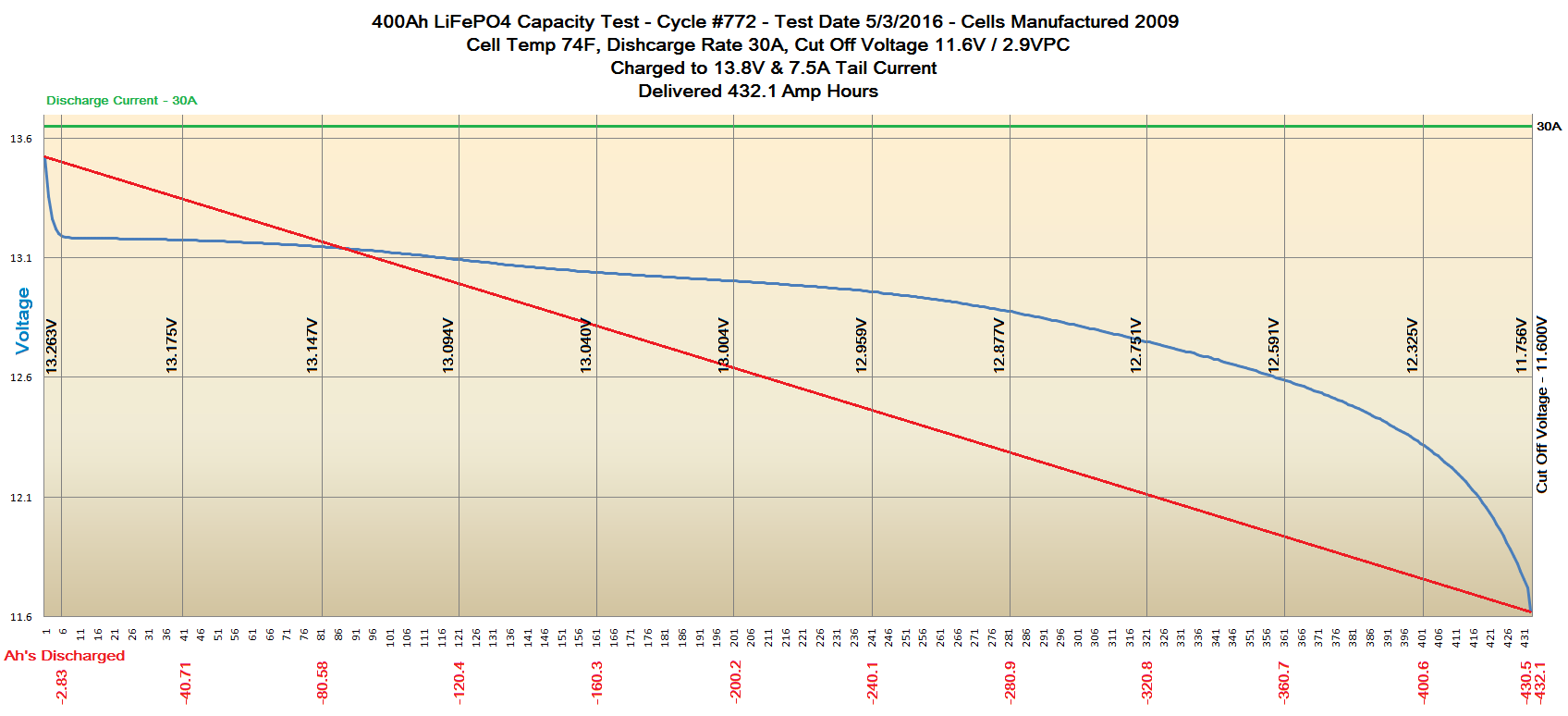
The Good:
#1 Well another year has gone by and the bank still has the same capacity it has always been able to deliver. At cycle 854 it delivered 431.6 Ah of capacity under a 30A continuous discharge load, same test as the last three or four capacity tests.
As of now the cells are 8.5 years old have almost 900 cycles to 80% DOD and capacity has not faded one bit. Simply amazing..
It does seem that all the testing an experimenting I did, to arrive at how to charge and care for them, has paid off.
#2 The ABYC is getting closer and closer to having a document of what will become the High Capacity Battery Standard. It is slow work, we're already approx three years in, but it is moving along.
The Bad:
#1 Hardly a week goes by when I don't hear from an RV'er, off grider or boater who has not destroyed thousands of dollars in LiFePO4 cells. Last week it was a guy with four "drop-in" 100Ah LPF batteries that have ruined his alternator, twice, and within 6 months can only deliver about 70% of their claimed capacity. He was charging them with a Declo alternator set at 14.6V in an RV....... Can't do that!!!! None of these batteries has blown up, experienced thermal runaway or caused a fire but bank after bank have been destroyed by corner cutting, penny-wise pound foolish installations, and treating LFP like they are lead acid. There is one thing all of these failures seem to have in common. The owners all read and heard WHAT THEY WANTED TO HEAR OR READ not what they SHOULD HAVE HEARD OR READ......
The number one stupid question I get asked, even after folks have read my article & others, is:
"What float voltage should I use for LiFePO4."
The answer is still: YOU DON'T FLOAT LFP!!
#2 BMS suppliers in the US are drying up like an apple in the desert. The BMS I use is no longer available with the owner moving on & citing similar issues I have had which resulted in me no longer doing LFP consulting or design work. That is folks were ignoring critical instructions, cutting corners and refusing to follow the design criteria. This has made the job of furnishing product, designing systems or consulting a risky proposition. As with almost everything, a few knuckle heads ruin it for everyone.
#3 Cell availability in the US is getting extremely difficult. No one wants to stock them, freight costs from China are outrageous and anyone who did want to stock them is sick of getting beat up by the "Well on Alibabba they cost"..... When you can find US stocked cells they are often not consecutive serial numbers and the ability to balance them, ensure matching internal impedance or ensure they have closely matching Coulombic efficiencies is getting tougher and tougher. As it is now I have to order cells through a company in CA who them orders them from Winston and it takes about 3-4 months for them to get here.
Is LiFePO4 any more prime time ready then when I started this thread? Unfortunately it is not. Sadly we seem to have actually regressed instead of making progress.. Off-grid marine fractional C use I am afraid will remain a rich mans battery or for the non-faint of heart only, at least for a while longer..
Full Resolution Link:
http://www.pbase.com/mainecruising/image/165366245/original.jpg
Discharge test graph cycle #772..

Happy 13th birthday to my LiFePo4 battery bank (5/9/2009)!
Back in 2007 the first lithium iron phosphate battery cells were just beginning to be manufactured and become commercially available. I dove in & began researching everything I could about lithium iron phosphate. Unfortunately back then there was scant white papers and scant research available. Anything that was available was behind a pay-wall at some university. I decided if I wanted to learn about lithium iron phosphate I needed to buy some cells & start experimenting. That was the only way I was going to learn. My first cells were small 100 Ah thundersky cells because they were relatively inexpensive and I didn't really care if I ruined them. being this early into a new technology I knew I was going to get some arrows in my back being a pioneer.This was all before cylindrical LiFepo4 cells even existed.it would've been much easier to destroy a few $10 wonderful cells than cells the cost me $200 apiece.
I wound up destroying those initial cells pretty quickly experimenting with charge voltages, how deeply you could cycle them & such. I quickly found out that they didn't really care how deeply you discharged them other than going below about 3.00 VPC. I quickly learned that the cells did not need to charge to anywhere near 3.65 V to attain 100% state of charge. I also learned that they did not like to be absorbed for longer than is absolutely necessary. On those early cells these batteries were quickly degraded if you left them on absorb for too long a duration. After all this testing and experimenting I finally decided to order a set of 400 amp hour Winston cells for my own vessel. It may sound hard to believe, that back in 2009 we had a lot more availability in battery management systems. Genasun was actually building a BMS Clean Power Auto had one and there are a number of others mostly designed for EV use but that can be modified for marine use . Other than Genasun the only BMS that was specifically designed for marine application was made by a company called Clean Power Auto. Demetri the owner of that company is now is the engineer at Lithionics.for perhaps 2000 cycles I use this clean power auto BMS. At that point I switched to a REC BMS.
For my own banks charging I decided on 13.8V @ roughly a .4C charge rate with a 30 minute absorption and no float. The primary charge source for this bank has been the alternator and a Balmar MC 614 regulator. While we had plenty of solar solar it remained off most of the time. We used this bank with just 30 minutes of engine runtime a day. This is pretty easy in Maine with the light winds we have in the summer. Doing all the charging from the alternator worked out perfectly. If we needed to stay at anchor for more than three days I would simply flip on the solar array just to slow the discharge. The original charge regime I set up for this bank back in 2009 has worked amazingly well. Today the battery has over 2300 cycles on it with almost every cycle going to at least 80% depth of discharge purposely. As of the last discharge capacity test the bank could still deliver the full 400 amp hours of capacity (Technically a little bit over). So, for those who say LiFePo4 hasn't been around long enough to see how long it actually lasts, I'd say 13 years & 2300+ cycles is pretty good data so I am personally sold.
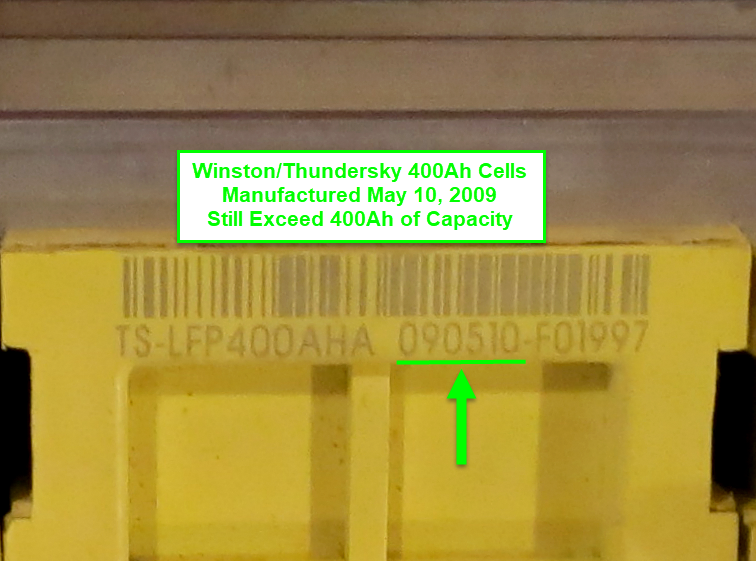
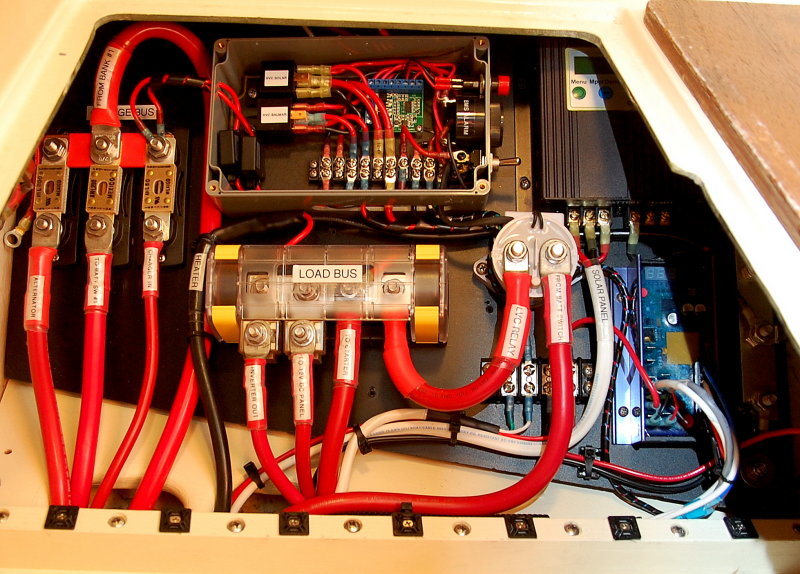
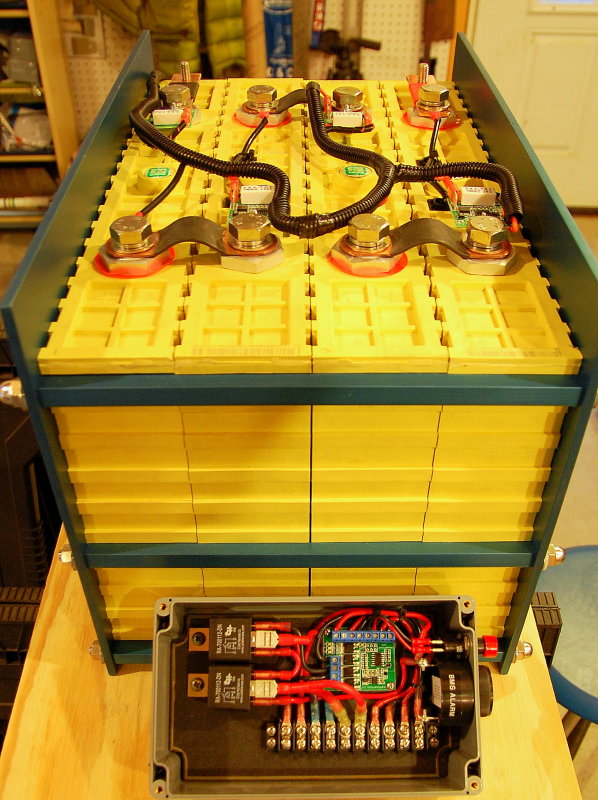
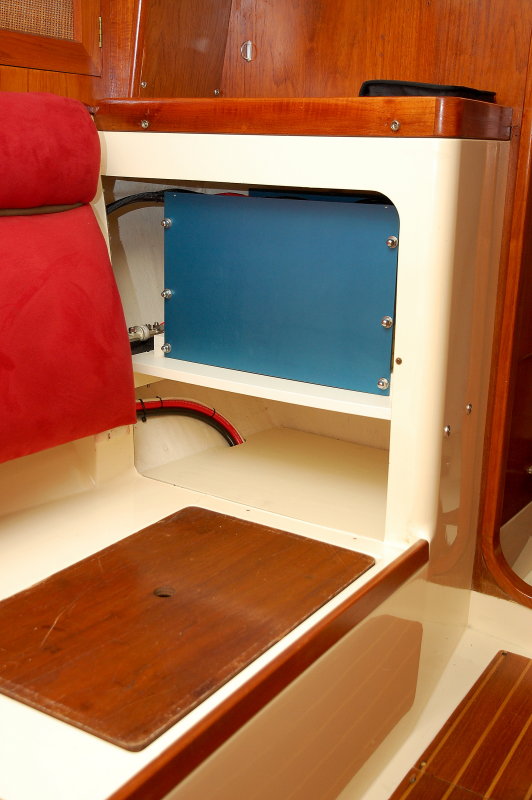
Back in 2007 the first lithium iron phosphate battery cells were just beginning to be manufactured and become commercially available. I dove in & began researching everything I could about lithium iron phosphate. Unfortunately back then there was scant white papers and scant research available. Anything that was available was behind a pay-wall at some university. I decided if I wanted to learn about lithium iron phosphate I needed to buy some cells & start experimenting. That was the only way I was going to learn. My first cells were small 100 Ah thundersky cells because they were relatively inexpensive and I didn't really care if I ruined them. being this early into a new technology I knew I was going to get some arrows in my back being a pioneer.This was all before cylindrical LiFepo4 cells even existed.it would've been much easier to destroy a few $10 wonderful cells than cells the cost me $200 apiece.
I wound up destroying those initial cells pretty quickly experimenting with charge voltages, how deeply you could cycle them & such. I quickly found out that they didn't really care how deeply you discharged them other than going below about 3.00 VPC. I quickly learned that the cells did not need to charge to anywhere near 3.65 V to attain 100% state of charge. I also learned that they did not like to be absorbed for longer than is absolutely necessary. On those early cells these batteries were quickly degraded if you left them on absorb for too long a duration. After all this testing and experimenting I finally decided to order a set of 400 amp hour Winston cells for my own vessel. It may sound hard to believe, that back in 2009 we had a lot more availability in battery management systems. Genasun was actually building a BMS Clean Power Auto had one and there are a number of others mostly designed for EV use but that can be modified for marine use . Other than Genasun the only BMS that was specifically designed for marine application was made by a company called Clean Power Auto. Demetri the owner of that company is now is the engineer at Lithionics.for perhaps 2000 cycles I use this clean power auto BMS. At that point I switched to a REC BMS.
For my own banks charging I decided on 13.8V @ roughly a .4C charge rate with a 30 minute absorption and no float. The primary charge source for this bank has been the alternator and a Balmar MC 614 regulator. While we had plenty of solar solar it remained off most of the time. We used this bank with just 30 minutes of engine runtime a day. This is pretty easy in Maine with the light winds we have in the summer. Doing all the charging from the alternator worked out perfectly. If we needed to stay at anchor for more than three days I would simply flip on the solar array just to slow the discharge. The original charge regime I set up for this bank back in 2009 has worked amazingly well. Today the battery has over 2300 cycles on it with almost every cycle going to at least 80% depth of discharge purposely. As of the last discharge capacity test the bank could still deliver the full 400 amp hours of capacity (Technically a little bit over). So, for those who say LiFePo4 hasn't been around long enough to see how long it actually lasts, I'd say 13 years & 2300+ cycles is pretty good data so I am personally sold.




Thanks for bumping this thread, somehow I missed it until now. You are definitely a pioneer on LFP and boats and I hope all your research and findings gets studied by manufacturers and users alike. Two things struck me reading through the past posts. One was that the same fears that existed then are bouncing around today despite over a decade of evidence on the safety of LFP. The other was that just when you seemed to believe LFP was going to fade away, they came booming back to become commonplace. What it the RVers? YouTubers? Any particular company? I am glad they have gained prominence and acceptance, and hopefully with your information users will learn to get the most out of LFP and avoid expensive mistakes that could still give LFP a bad name in the future.
